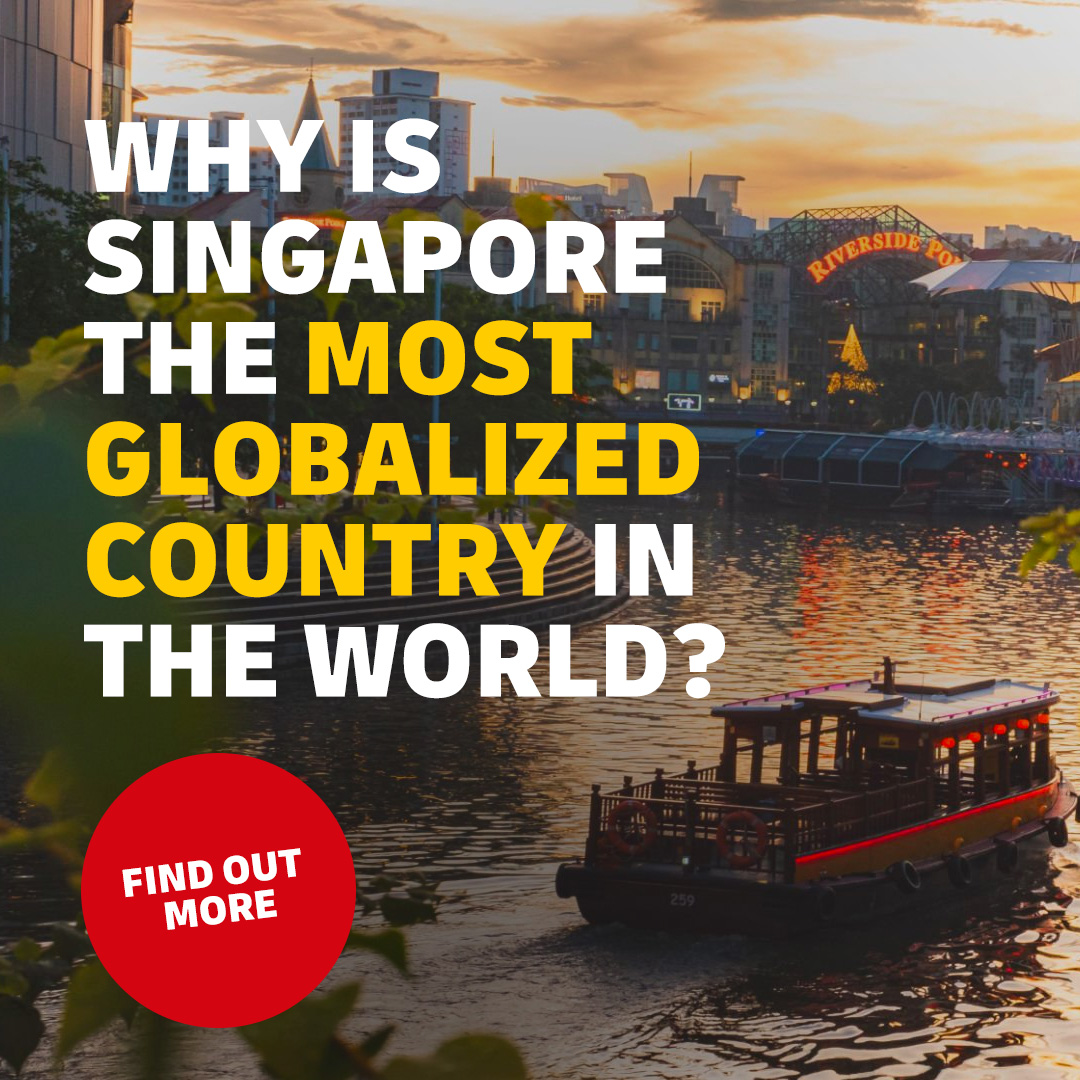It tracks how flows of trade, capital, information, and people move around the world and measures the globalization of 181 countries and territories.


The report reveals that globalization reached a record high in 2022 and remained close to that level in 2023 – despite a series of global shocks over the past decade, including the Covid-19 pandemic, wars in Ukraine and Gaza, the U.S. – China trade conflict, and the UK's withdrawal from the EU. The evidence strongly rebuts the notion that the growth of global flows has gone into reverse.
Trade growth played a crucial role in boosting global connectedness. The share of global output traded internationally was back to a record high level in 2022. After a slowdown in 2023, trade growth is forecast to accelerate in 2024. The globalization of information flows has been especially strong over the past two decades, even though the latest data show a stall in their growth, partly due to less research collaboration between the U.S. and China. Corporate globalization is rising, with companies expanding their international presence and earning more sales abroad.
The report affirms the considerable potential to continue growing global flows. It pegs the world's current level of globalization at only 25%, on a scale from 0% (meaning no flows cross national borders) to 100% (borders and distance have ceased to matter at all).
Commenting on the findings for the region, Ken Lee, CEO for Asia Pacific, DHL Express, said, "We continue to see the resilience of globalization, and its profound impact on cross-border trade between Asia and the rest of the world. Trade demands within Asia also remain strong due to the establishment of several trade agreements. As a trade facilitator, we firmly believe that globalization is a powerful force that has huge potential to reinvigorate economic growth. We will leverage our global network to boost interconnectivity and enhance opportunities for our customers. Our digital tools such as Global Trade Services will also help more companies trade internationally by making it easier for them to understand the customs and regulations of the markets they want to enter."
Ranking of most globalized markets: Singapore at the top, followed by the Netherlands as #2 and Hong Kong #10
In the new ranking of the world's most globally connected markets, Asian economies Singapore and Hong Kong come in among the top 10, with Singapore coming in first. It is ranked first on 'depth' as it has large international flows relative to the size of its domestic economy, due in part to its public policy to effectively integrate itself into the global economy. Singapore has also topped the charts on the trade and capital pillars. Singapore's total merchandise trade between 2019 and 2022 jumped 33 percent from approx. EUR701 billion to EUR937 billion (S$ 1,022.2 billion to S$ 1,365.4 billion).
"Singapore has invested heavily in strengthening our physical and digital connectivity to the world because trade is our lifeblood. We continue to enhance our connectivity and trade links to remain a critical and trusted node in global supply chains, facilitating international trade and flows of capital, information and talent. We look forward to partnering with global companies seeking a launchpad for business growth and supply chain expansion in Asia-Pacific and beyond," said Ih-Ming Chan, Executive Vice President, Singapore Economic Development Board.
Hong Kong is placed at the 10th position. Its global connectedness reaffirms the state's position as a gateway for flows between Mainland China and the rest of the world. It also signals the growing importance of the Greater Bay Area along with Macau's advance in ranking.
Intra-Asia trade flows remain strong while the West remain key trading partners of Asia
Evidence shows that markets in Asia Pacific are strongly connected with each other in the region. In fact, at least 70 percent of the countries in Asia Pacific have strong flows with their Asian counterparts. Looking at these countries' top 10 connections, six or more are with an Asia Pacific market, citing robust intra-Asia trade. The Asian region is also closely connected with the West, with many of them having the United States or United Kingdom as their top 10 connections.
Globalization has not given way to regionalization
Further, the report shows that predictions of a global shift from globalization to regionalization are not – at least yet – borne out in patterns of international flows. In fact, most international flows are taking place over stable or even longer distances, with a declining share happening inside major geographic regions. In the realm of trade, only North America shows a clear shift to more regionalized trade patterns.
"Deglobalization is still only a risk, not a current reality," says Steven Altman, Senior Research Scholar and Director of the DHL Initiative on Globalization at NYU Stern's Center for the Future of Management. "Geopolitical threats and public policy shifts have led many to predict a fracturing of the world economy along geographic or geopolitical lines, or even a retreat from international to domestic business. But the latest data still show that international flows are growing and very few countries are cutting ties with their traditional counterparts. It is important to recognize the resilience of global flows because a lopsided focus on the threats to globalization could make deglobalization a self-fulfilling prophecy."
U.S. - China ties diminish, and Russia shows unprecedented decline in global connectedness, but no wider split of the world economy between rival blocs
The DHL Global Connectedness Report also shows that U.S.-China ties continue to diminish, with the shares of both countries' flows involving each other decreasing by about one-quarter since 2016. However, both countries remain significantly connected, demonstrating larger flows than almost any other pair of countries. Russia and Europe have decoupled, resulting in Russia facing an unprecedented drop in connectedness, more than twice as much as any previous decline on record among the world's 20 largest economies. At the same time, the data analysis demonstrates that there is no wider split of the world economy between rival geopolitical blocs.
The DHL Global Connectedness Report
Published regularly since 2011, the renowned DHL Global Connectedness Report (previously DHL Global Connectedness Index) provides reliable findings on globalization trends by analyzing 15 types of international trade, capital, information, and people flows. The 2024 edition is based on almost nine million data points. It ranks the connectedness of 181 countries, accounting for 99.7 percent of the world's gross domestic product and 98.7 percent of its population. A collection of 181 one-page country profiles provides concise summaries of individual countries' globalization patterns.
The report was commissioned by DHL and authored by Steven A. Altman and Caroline R. Bastian of New York University Stern School of Business.
Note to editors:
The report and further resources are available at dhl.com/globalconnectedness.
Hashtag: #DHLExpress #GlobalConnectednessReport #Globalization
https://group.dhl.com/en.html
https://www.linkedin.com/company/dhl
https://twitter.com/DHLGlobal
https://www.instagram.com/dhl_global/?hl=en
The issuer is solely responsible for the content of this announcement.
DHL – The logistics company for the world
DHL is the leading global brand in the logistics industry. Our DHL divisions offer an unrivaled portfolio of logistics services ranging from national and international parcel delivery, e-commerce shipping and fulfillment solutions, international express, road, air and ocean transport to industrial supply chain management. With about 395,000 employees in more than 220 countries and territories worldwide, DHL connects people and businesses securely and reliably, enabling global sustainable trade flows. With specialized solutions for growth markets and industries including technology, life sciences and healthcare, engineering, manufacturing & energy, auto-mobility and retail, DHL is decisively positioned as "The logistics company for the world".
DHL is part of DHL Group. The Group generated revenues of more than 81.8 billion euros in 2023. With sustainable business practices and a commitment to society and the environment, the Group positively contributes to the world. DHL Group aims to achieve net-zero emissions logistics by 2050.
New York University Stern School of Business, located in the heart of Greenwich Village and deeply connected to the City after which it is named, is one of the United States' premier management education schools and research centers. NYU Stern offers a broad portfolio of transformational programs at graduate, undergraduate, and executive levels, all of them enriched by the dynamism and profound resources of one of the world's business capitals. NYU Stern is a welcoming community that inspires its members to embrace and lead change in a rapidly transforming world. Visit www.stern.nyu.edu.


















